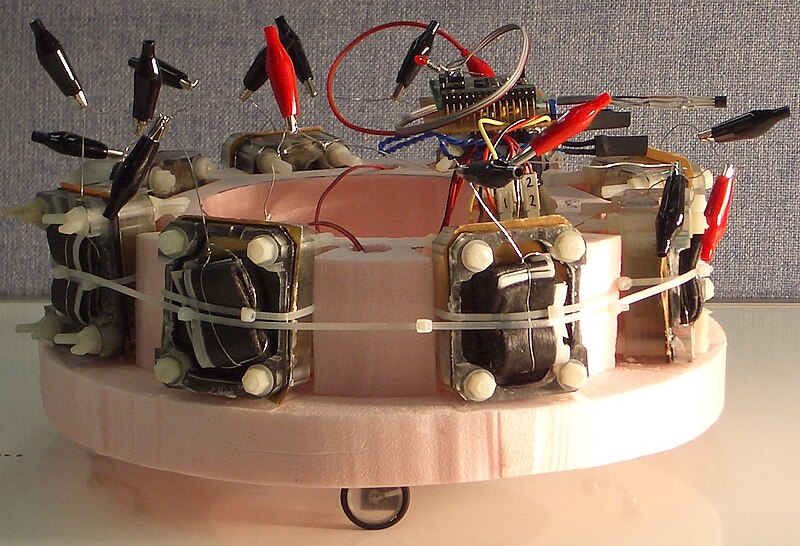concept:
- making of bioreactor - decomposing horse meat into energy
- construction of robot
- construction of trajectory for robot and its handling of bioreactor
1) bioreactor
development of complex bioreactor decomposing (artificial digestion/dialysis) horse meat:
Where we can get energy
- methane CH4
- from enzymes/proteins decomposing
- temperature rising (to little ?)
- plan B (from fat - possibly pig/cow)
We can predict that we will need up to four different environments in different state of process of decomposing: probably in some there will be oxygen in other not, in some a lot of fluid other not, Each environment should have its own measuring device (measuring level of oxygen, temperature etc.) - if we can get different energy supplies from different environment better (CH4, electricity etc.) -where one process is finished it respond through radio-signal with robot which is using this energy for movement but also for arranging different environments (with water etc.)
Start of the beginning of the process is first accumulation of energy - later we presume constant energy flow
References: Ecobot I - III: energetically autonomous robots that can remain self-sustainable by collecting their energy from material, mostly waste matter, in the environment on Wiki
diagram link
1)
2)
main literature:
''The work focused on the construction of a complete MFC-based self-regulating energy system which necessitated exploring mechanisms for (1) collecting, ingesting (eating) new substrate (2) removing waste material (3) maintaining internal homeostasis and (4) performing appropriate behavior for the foraging/ acquisition of food.''
read the whole article
reference also: Venus flower
- making of bioreactor - decomposing horse meat into energy
- construction of robot
- construction of trajectory for robot and its handling of bioreactor
1) bioreactor
development of complex bioreactor decomposing (artificial digestion/dialysis) horse meat:
Where we can get energy
- methane CH4
- from enzymes/proteins decomposing
- temperature rising (to little ?)
- plan B (from fat - possibly pig/cow)
We can predict that we will need up to four different environments in different state of process of decomposing: probably in some there will be oxygen in other not, in some a lot of fluid other not, Each environment should have its own measuring device (measuring level of oxygen, temperature etc.) - if we can get different energy supplies from different environment better (CH4, electricity etc.) -where one process is finished it respond through radio-signal with robot which is using this energy for movement but also for arranging different environments (with water etc.)
Start of the beginning of the process is first accumulation of energy - later we presume constant energy flow
References: Ecobot I - III: energetically autonomous robots that can remain self-sustainable by collecting their energy from material, mostly waste matter, in the environment on Wiki
diagram link
1)
2)
3)
main literature:
integration between biology and machines has been described as (artificially) symbiotic and has resulted in the introduction of a new class or robots known as Symbots
-
''The work focused on the construction of a complete MFC-based self-regulating energy system which necessitated exploring mechanisms for (1) collecting, ingesting (eating) new substrate (2) removing waste material (3) maintaining internal homeostasis and (4) performing appropriate behavior for the foraging/ acquisition of food.''
-
Polymeric food molecules (starch, chitin, proteins, saccharides) are hydrolysed by microbial enzymes to give monomeric molecules that can be taken up by the cells. Fermentation produces organic acids as the main end-products of metabolism, including acetate, propionate, butyrate, lactate, formate, alcohols and carbon dioxide. The acids produced would normally be expected to reduce the pH. The organic acids (e.g. acetate) are circulated to the MFC units where electrogenic species utilise them by oxidation, through the abstraction of electrons (via the electrode) and producing carbon dioxide and more protons. However, the build-up of acids (and resulting low pH) does not appear to occur, possibly because of one or more of the following reasons: (i) the anaerobic sludge microbes forming into robust and stable biofilms, naturally buffering their surroundings (concomitant production of ammonia and other basic molecules at a rate which neutralises the pH); (ii) loss of acids through volatilization; (iii) effective removal of protons by the MFC cathodic system (PEM and cathode). The latter mechanism appears to be the most important and the system maintains pH homeostasis throughout continuous operation. Alternative designs of cathode employ closed chambers with either chemical electrolytes, fast running water or aerated water. All these systems require high amounts of energy to remain operational and help catalyse the reaction: O2 + 4e- + 4H+ ↔2H2O [+0.82]. In the cases where the chemical electrolyte is fully reduced, or the water/air stops Proc. of the Alife XII Conference, Odense, Denmark, 2010 740 flowing, then the cathodic system no longer acts as the oxidising half-cell, and the H+ ions generated in the anode (cations) cannot find their electrochemical path through to the cathode, thus accumulating to lethal levels for the microbes. The open to the air/periodically moistened cathode, might not be as efficient as the aforementioned alternatives at the initial stages of the MFC lifetime, however it continuously improves with time and eventually outperforms all other systems, especially in terms of longevity. It would be interesting to see (as part of future work) what happens if the robot is fed acid or alkaline mixtures of feedstock, or whether acid build-up does occur when the MFC are electrically disconnected.read the whole article
reference also: Venus flower





No comments:
Post a Comment